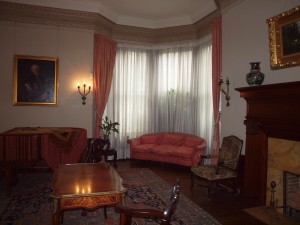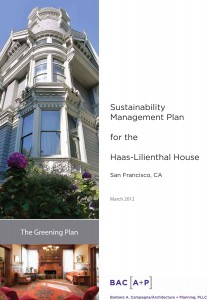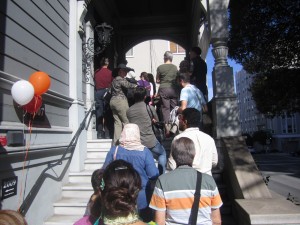San Francisco Architectural Heritage has just posted on their website the final Sustainability Management Plan that I worked with them to develop over the past six months. The Haas-Lilienthal House Sustainability Management Plan is the result of an eco-charrette held in August 2011 to identify greening opportunities and to target the appropriate green rating system and certification level. And now the house is one of a growing number of historic buildings seeking LEED EB certification.
Keeping a Historic House Museum Relevant
The plan states, “While the board of Heritage has targeted LEED Gold, there is the potential that the projects could be ‘stretched’ to reach the goals of net
zero.” Heritage is excited by this news that is only the beginning of a
long-term project to make the Haas-Lilienthal House a model for exemplary
sustainability practices.
What is the House?
The Haas-Lilienthal House, a pristine 1886 Victorian mansion with most of its contents intact, was given to Heritage in 1973 by members of the Haas and Lilienthal families, who were among the city’s most prominent early residents. The House was designed by renowned Victorian architect Peter Schmidt, listed in the National Register of Historic Places in 1973, and designated a San Francisco Landmark in 1975. It is an exuberant example of the Queen Anne style, with prominent open gables, varied styles of shingles and siding, and a turreted corner tower topped by a “witches cap” roof.
Today, it serves myriad functions: as a house museum, a venue for meetings, lectures and social events, and as Heritage’s administrative offices,
library, and archive. Through a variety of activities including Heritage Hikes for schoolchildren, the House is the centerpiece of Heritage’s education program and has become an exemplar of responsible stewardship. In a city so closely identified with its collection of “Painted Ladies,” the Haas-Lilienthal House is the only publicly accessible Victorian domestic interior. A dedicated corps of over 60 volunteers leads weekly tours of the House and walks exploring surrounding neighborhoods.
The Greening Plan
The baseline target for the Haas-Lilienthal House Sustainability Management Plan is to implement much-needed capital improvement projects while
overhauling maintenance and stewardship policies and procedures. As a traditional building, it is important to start by identifying the original
design features that contribute to the management of heat, air and light. Simple steps to leverage existing features include:
1. Reactivate operable windows and operate in conjunction with ventilation goals.
2. Properly use high ceilings and transoms above doors/windows for ventilation.
3. Utilize roofs and porches with wide roof overhangs to manage heating and cooling.
4. Use interior pocket doors to compartmentalize spaces and control heating and cooling.

Haas-Lilienthal House Living Room – high ceilings, operable windows and heavy curtains can be used to control energy use.
A guiding premise of the Plan is that the House should meet energy and sustainability goals while preserving its character-defining and
historically significant features. Therefore, each recommendation was evaluated against whether it could save energy and material resources, while respecting character-defining elements. Recommendations for the strategic approach include the following steps to be implemented sequentially or in tandem depending on the construction schedule and funding campaign:
1. Determine which capital improvements will be undertaken and whether construction will be phased.
2. Conduct an energy audit.
3. Develop a weatherization program.
4. Develop a green housekeeping program.
5. Initiate a comprehensive maintenance and operations program using LEED EB:O&M.
6. Conduct a major rehabilitation.
7. Stretch Goals – Net Zero.
If you are interested in learning more about this project and its goals, feel free to download the full report from the Heritage website. And this project will be presented at several upcoming conferences – the AIA Convention in May in DC (Friday, May 17th at 2 PM), the University at Buffalo Sustainable Preservation workshop in June in NYC (Monday, June 11th), and the AASLH conference in Salt Lake City in October.
And if you’d like to “subscribe” or follow this blog, True Green Cities, please sign up through the “Subscribe” button at the bottom left of this page. You’ll receive a daily recap when new blogs are posted.


